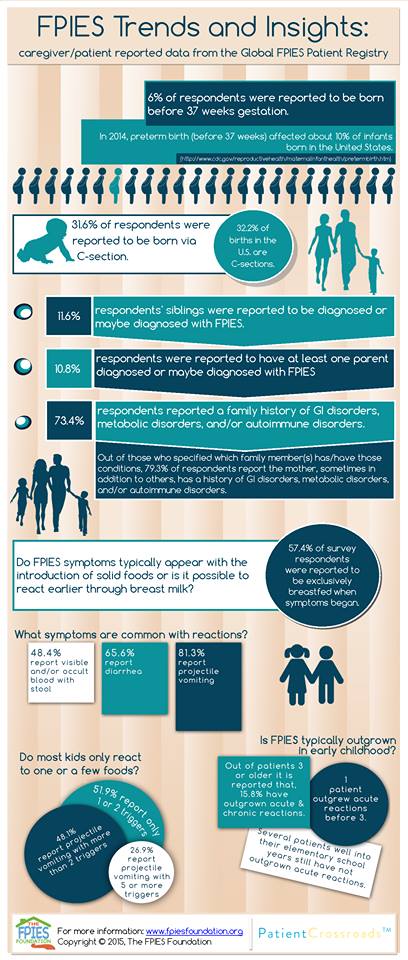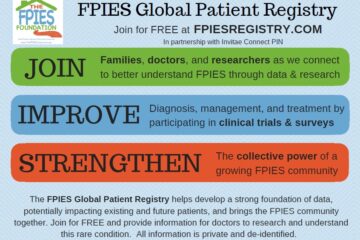More Insights from the Global Patient Registry
by Hilary Lagerwey
Last year we shared some statistics gleaned from the data provided by FPIES families across the globe. The Global Patient Registry is a platform to collect information such as medical history, family history, and specific symptoms. The purpose behind this data repository is to both help families glean some insights into this rare disease and also give researchers some direction so that the whole FPIES community can learn more. The information you all have already provided is invaluable and we are always looking for more people to take the surveys.
In our last report we examined what FPIES looks like so this year we decided to focus on medical and family history. Although no one knows exactly what causes FPIES, data such as this can possibly help further our collective understanding.
As you look through this data for yourself, it is important to note that these are informational survey’s and not collected in the same ways as other types of research such as a scientific study. The data comes from volunteer respondents and all of the information is patient/caregiver reported. Some families might be more likely than others to participate in the survey, and while this means the numbers here may skew towards the more severe and more protracted cases, we feel it is still important to give a voice to this group of FPIES patients. The more data we have the more we can learn and share with researchers. In sharing this information and analysis, our intent is not to present these statistics as conclusions, but as starting points for a discussion amongst the community. This article is just the beginning of these conversations!
When looking at statistics like this for a certain sub-population, in this case FPIES patients, it is most useful if you have a number to compare that to in the general population. For some of these numbers we do have a reasonable idea of how FPIES patients compare to the general population, and for some of these numbers we know less.

Again, keeping in mind that these are survey responses and not a specific scientific study, this information does not support the idea that birth circumstances (C-section births or prematurity) play a strong role in the development of FPIES. The percentages of C-section births and premature births are slightly lower for the FPIES population than the general U.S. population. (Note that this isn’t an examination of whether those numbers are statistically significantly lower, but they certainly aren’t dramatically higher.)
Looking at first degree relatives of FPIES patients (parents and siblings) can help get an idea of whether FPIES tends to cluster in families. Unfortunately at this time the prevalence of FPIES in the general population is not known so we have nothing to directly compare these numbers to, but as awareness spreads and research continues, perhaps we will soon know more about the overall prevalence. If we assume the population prevalence is less than 1 in 10 then this data might suggest a tendency for FPIES to cluster in families. The next question to ask would be does that clustering indicate a genetic component, or some sort of shared environmental factor such as the microbiome, or a combination of those factors?
These statistics that shows a seemingly high prevalence of GI disorders, metabolic disorders, and autoimmune disorders in the family history of FPIES patients, and especially the mothers, are perhaps the most interesting but also the least straightforward of this list. At first glance, this makes one question if there is some sort of genetic link here between GI disorders, metabolic disorders, and autoimmune disorders and FPIES. But we must also keep in mind that this is a pretty broad category of diseases so the number of cases you would expect in the general population is probably fairly high and also tricky to estimate for a number of reasons.
It is also interesting that in our sample GI disorders, metabolic disorders, and autoimmune disorders seemed to disproportionately affect the mother. Does this suggest some sort of environmental factor in utero that contributes to FPIES? Or is this simply reflecting the fact that autoimmune diseases disproportionately affect women and the fact that women are more likely to go to the doctor and therefore more likely to be diagnosed with any condition? Or some combination of all of these things?
As you can see this data can be very useful and we as a community can help encourage more research so that we can all learn more. This data is very preliminary and these discussions are just the beginning. Please take the survey if you have not already so we can all continue to learn more!
This post is written by FPIES Mom and FPIES Foundation volunteer, Hilary Lagerwey. Graphic created by FPIES Mom and FPIES Foundation volunteer, Melissa Rice.


